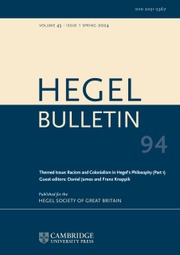No CrossRef data available.
Article contents
What is Living and What is Dead in Croce's Interpretation of Hegel*
Published online by Cambridge University Press: 23 June 2015
Abstract
Croce's appreciation of Hegel was always as ambivalent as the title of his famous study suggests. Indeed, although related to two of the major 19th century exponents of Italian Hegelianism – Bertrando and Silvio Spaventa his first encounter with Hegel had been one of almost total rejection. As he wrote to the philosopher Donato Jaja in 1892, ‘I believe that the fundamental principles, and especially the method, of that system are entirely erroneous; and the damaging consequences of this error will become plain when applied to particular disciplines’. The study of Marx and the influence of Gentile and Labriola, however, led him to review his earlier position and in 1906 to translate the Encyclopedia and to write the accompanying book What is living and what is dead in the Philosophy of Hegel. Thereafter Croce, who had already completed his Aesthetic (1902) and the first edition of the Logic (1905), was increasingly to present his own philosophy as a sustained commentary on, and development of, Hegel's philosophy. An examination of his classic study of Hegel thus provides an important insight into salient features of Croce's own philosophical system as it later developed.
- Type
- Article
- Information
- Bulletin of the Hegel Society of Great Britain , Volume 5 , Issue 1: number 9 , Spring/Summer 1984 , pp. 5 - 14
- Copyright
- Copyright © The Hegel Society of Great Britain 1984
Footnotes
Research for this article was made possible by the award of a Leverhulme Study Abroad Studentship.
References
Notes
1. Letter quoted in Garin, E. ‘Appunti sulla formazione e su alcuni caratteri del pensiero crociano’ in Intellettuali italiani del XX secolo (Roma, 1974), p. 6 Google Scholar.
2. For a more detailed study of this problem see my Liberalism and Historicism: History and Politics in the Thought of Benedetto Croce, Cambridge University PhD dissertation, 1983, especially ch.1Google Scholar.
3. All references, unless otherwise stated, are to Ció che é vivo e ció che é morto nella filosofia di Hegel in Saggio sullo Hegel, 4th ed. (Bari, 1948), pp. 3–143 Google Scholar. All translations are my own.
4. The passage referred to is in the Encyclopedia of the Philosophical Sciences, Vol. I, para. 244. Croce devotes the whole of ch. 10 to this problem.
5. He develops this argument in ch. 5 where he discusses Hegel's Logic.
6. Mure, G.R.G. argues forcibly that this is not the case e.g. An Introduction to Hegel (Oxford, 1940) ch. 8, paras. 6, 6.1, 7Google Scholar and A Study of Hegel's Logic (Oxford, 1950) ch. 1, para. 2.1Google Scholar, although I believe that his canparison with Kant and Aristotle is more telling than he intended (Study, chs. 20, 21). See Croce's appreciative comments on Mure's view of his revision of Hegel in his review of these books, ‘Un critico inglese della logica di Hegel’ in Indagini sul Hegel (Bari, 1952) pp. 92–7Google Scholar.
7. I have developed this argument in my ‘Croce, Gentile and Hegel and the doctrine of the ethical state’, forthcoming in Rivista di studi crociani and ‘Liberalism and historicism, ch. 3.
8. Cp. Croce, B. ‘La storia ridotta sotto il concetto generale dell'arte’ in Atti dell'Accademia Pontaniana XXIII (1893), Memoria n.7, 1-32Google Scholar, and in Primi Saggi, 2nd ed. (Bari, 1927) pp. 3–46 Google Scholar, discussed in my Liberalism and historicism, pp. 6-12.
9. Hegel's Philosophy of Right, trans. Knox, T.M., (Oxford, 1952) p. 10 Google Scholar. I have rendered Croce's translation of this phrase. For the importance of the Hegelian motto for Croce's, thought see Indagini sul Hegel, pp. 10–11 Google Scholar.
10. See Encyclopedia, vol. I. para. 187, Zusatz and Croce's, comment in Saggio sullo Hegel p. 137 Google Scholar.
11. Hegel's Phenomenology of Spirit, trans Miller, A.V. (Oxford, 1977) para 17Google Scholar.
12. See on this Fackenheim, E. The Religious Dimension in Hegel's Thought (Indiana, 1967), pp. 98-9, 106–7Google Scholar and Forbes', Duncan ‘Introduction’ to Hegel's Lectures on the Philosophy of world History: Introduction, trans. Nisbet, H.B., (Cambridge, 1975)Google Scholar. All references in the text to this edition of the work are indicated LPhWH.
13. Compare Phengnenology, para. 785, para 808.
14. See Forbes, ‘Introduction’ and Plant, R., Hegel: An Introduction, 2nd ed. (Oxford 1983) ch. 10Google Scholar.
15. Saggio sullo Hegel, pp. 145-72.
16. For the importance of this insight in the genesis of Hegelianism see Walsh, W.H., Metaphysics (London, 1963) pp. 133–53Google Scholar.
17. This seems to be the case with those recent interpreters of Hegel like Charles Taylor who reject his metaphysics as unbelievable but nevertheless wish to hold onto his method, cp. Taylor, Charles, Hegel (Cambridge, 1975), ch. 3CrossRefGoogle Scholar. The two, however, are inextricably linked, as this paper has sought to show.


